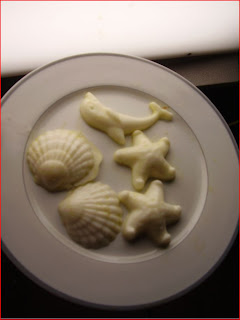Soapmaking and cedar I: Adventures in organic chemistry
In connection with the multidisciplinary and multi-institutional initiative with Northwest Indian College to incorporate the use of traditional native plants and foods into addressing diabetes, the Seattle Art Museum hosted a tour of the exhibit S'abadeb ("Radiant Gifts" from artists of the Salish peoples of the Northwest Coast and Puget Sound area), and a tour of the native plants at the garden at the Olympic Sculpture Park.
One of the activities when we got back to the building was making cedar oil. The instructor had already harvested small cedar branches, and she put us to work cutting the needles into small pieces--the smaller the better, since that exposes more surface area. That was pretty much all we had time for at the end of a full day of activities, so she sent us home with instructions for making an infusion of cedar oil from cut needles.
I went out and got some cedar needles of my own and cut them into small pieces for simmering. However, my cedar was very young, and smelled more astringent than the cedar she had provided, so I was not sure how this was going to work.
As she had described, I covered the cedar needles with about 1/2" of extra-virgin olive oil, and turned it to "low" to simmer. "Low" turned out to be too low to keep it warm enough, so later on, it spent most of the time on "medium-low", which provided a nice steady simmer.
The house smelled nice and cedary for the next week, as I kept it on simmer whenever I was home in the evening. I had asked previously if I needed to do anything special when I turned it off to go to work in the daytime. Obviously, traditional ways of cooking and creating oils didn't use to have to accommodate the 9-5 (or later); in fact, long ago in Navajo class, our teacher mentioned the effect that had on people's ability to attend days-long ceremonies, and how it was modifying traditional practice. But there was no need to do anything more than cover it and leave it on the stove; it wasn't going to go rancid as a result.
Oil goes rancid when it oxidizes; the point of simmering it for a week is to get all the water in the plant material to evaporate, so that it can't promote oxidization of the long hydrocarbon chains in the oil. After a week of simmering, a good deal of the astringent smell of the young cedar had disappeared, so I'm guessing that a large part of that quality was water-borne as well.
After the week was up, I strained the needles out of the infusion, and had about a cupful of strongly cedar-scented oil:

It was nice, but I wanted to craft more than just oil, so I decided to break out the soapmaking supplies I had recently gotten. There are several ways of making soap; the traditional and most labor-intensive way involves a chemical reaction between a strong base (usually lye) and fats, releasing a lot of heat and corrosiveness (we actually melted a thermometer at Terry's house making soap once!), so until I have a better workspace, I'm going with the less dramatic melted-glycerine method.
Melted glycerine soapmaking is pretty much what it sounds like--glycerine is a white solid; you melt it, add colors and scents that you want for the soap, and pour it into a mold to set. I decided cedar oil soap would be a nice thing to make, and set about mixing my fresh cedar oil into the melted glycerine.
This is how the first batch of soap came out.
 |  |
Can you see my mistake yet?
It's basic organic chemistry--I had not bothered to look up glycerine to see whether it was hydrophilic or hydrophobic; I just assumed that--like the olive oil--it was hydrophobic.
Hydrophilic and hydrophobic (as in "rabies" :) are physical properties of molecules, referring to their distribution of electrical charge. Very briefly, and probably criminally oversimplified, if a molecule has a positive charge at one end and a negative charge at the other, it tends to dissolve in other polar solvents, such as water, and is said to be "hydrophilic". Similarly, if a molecule does not have charged ends in that way, such as the long hydrocarbon chains in oils, then it tends to dissolve in non-polar solvents such as oils, but not in water, and is said to be "hydrophobic". This is, by the way, why oil and vinegar don't mix; vinegar is polar (hydrophilic) and oil is hydrophobic.
You see how the oil in my soap pieces is collected in spots, with lots of white glycerine in between? That means that the oil did not dissolve in the glycerine, as I had planned/hoped/expected it would.
Sure enough, wiki-ing "glycerine" yielded the following information, dammit:
Glycerol has three hydrophilic hydroxyl groups that are responsible for its solubility in water and its hygroscopic nature.
Had I bothered to look that up before just plunging in, I would not have wasted some of my cedar oil. And the soap came out pure glycerine, as all the cedar oil floated to the top and washed away (you can also see where I overfilled one of the seashells, and it ran over, erasing the boundary--note to self: even if I have a little left over, don't try to cram it all in, because that doesn't work). Oh, well, lesson learned.

Knowing belatedly that glycerine is hydrophilic, I switched to water-based herbal infusions, which worked out a lot better. I'll show how those turned out in the next post, as this one is getting quite long.

0 Comments:
Post a Comment
<< Home